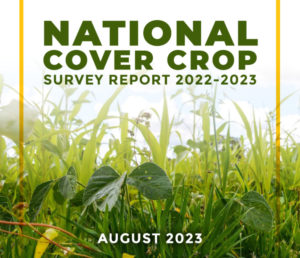 The 2022-2023 National Cover Crop Survey Report was released today the challenges assumptions on the role of incentive payments in cover crop adoption.
The 2022-2023 National Cover Crop Survey Report was released today the challenges assumptions on the role of incentive payments in cover crop adoption.
According to the survey, nearly half of the cover crop users participating in the survey reported receiving some sort of payment for cover crops in 2022, and almost 78% of cover crop non-users said incentive payments would be helpful. However, over 90 percent of the farmers who were receiving cover crop incentives reported that they would definitely or probably continue planting cover crops after the payments ended, while only 3.3% said they definitely or probably would drop cover crops at the end of the incentive program. Overall, less than 16% of cover crop users said receiving incentive payments was one of their goals for cover cropping.
“What the survey showed is that cover crop incentive payments are an important factor in encouraging and helping farmers to transition into cover cropping, but once they see the soil health improvements and other cover crop benefits, most stick with cover crop planting long after the incentives end,” said Dr. Rob Myers with USDA-NIFA North Central Sustainable Agriculture Research and Education (SARE) program and lead researcher for the survey.
 The 2022-2023 report marks the seventh National Cover Crop Survey, issued jointly by SARE, Conservation Technology Information Center (CTIC) and the American Seed Trade Association (ASTA), based on insights from nearly 800 farmers in 49 states. The survey series started in 2012, and data from the surveys has been used in academic research, educational programs, policy planning and even testimony to Congress.
The 2022-2023 report marks the seventh National Cover Crop Survey, issued jointly by SARE, Conservation Technology Information Center (CTIC) and the American Seed Trade Association (ASTA), based on insights from nearly 800 farmers in 49 states. The survey series started in 2012, and data from the surveys has been used in academic research, educational programs, policy planning and even testimony to Congress.
“The National Cover Crop Survey goes beyond acreage statistics by providing insights into what farmers want to achieve with cover crops, what motivates them to try and continue the process, how cover crops relate to other soil-building practices like no-till, and their approaches to using the practice,” says Ryan Heiniger, executive director of CTIC. “We are also just as interested in the perspectives of non-users of cover crops. Understanding their concerns and information needs provide direction for developing better outreach materials, and can help policymakers clear obstacles that hamper adoption or create more attractive incentives.”
Andy LaVigne, president and CEO of ASTA, adds that the survey provides seed producers with valuable insight on cover croppers’ needs. “Our members are extremely interested in learning about the needs of growers when it comes to which varieties they’re seeking and when and how they make cover crop planting decisions,” LaVigne says. “These perspectives help the seed industry plan ahead to ensure that farmers have the species they want as well as genetics that help them manage their cover crops effectively to achieve their goals.”
This was the first survey to explore livestock in cover crops, and it found 25% of respondents integrated livestock into their cover crop program. Of those who grazed cover crops, 76% reported a net increase in profit from the practice.
Get more details on the survey in this presentation with Heiniger, LaVigne, and Dr. Myers – read the full report.
2022-2023 Cover Crop Survey (39:06)
Interview with ASTA President and CEO Andy LaVigne
Cover Crop Survey interview with Andy LaVigne, ASTA (6:12)

